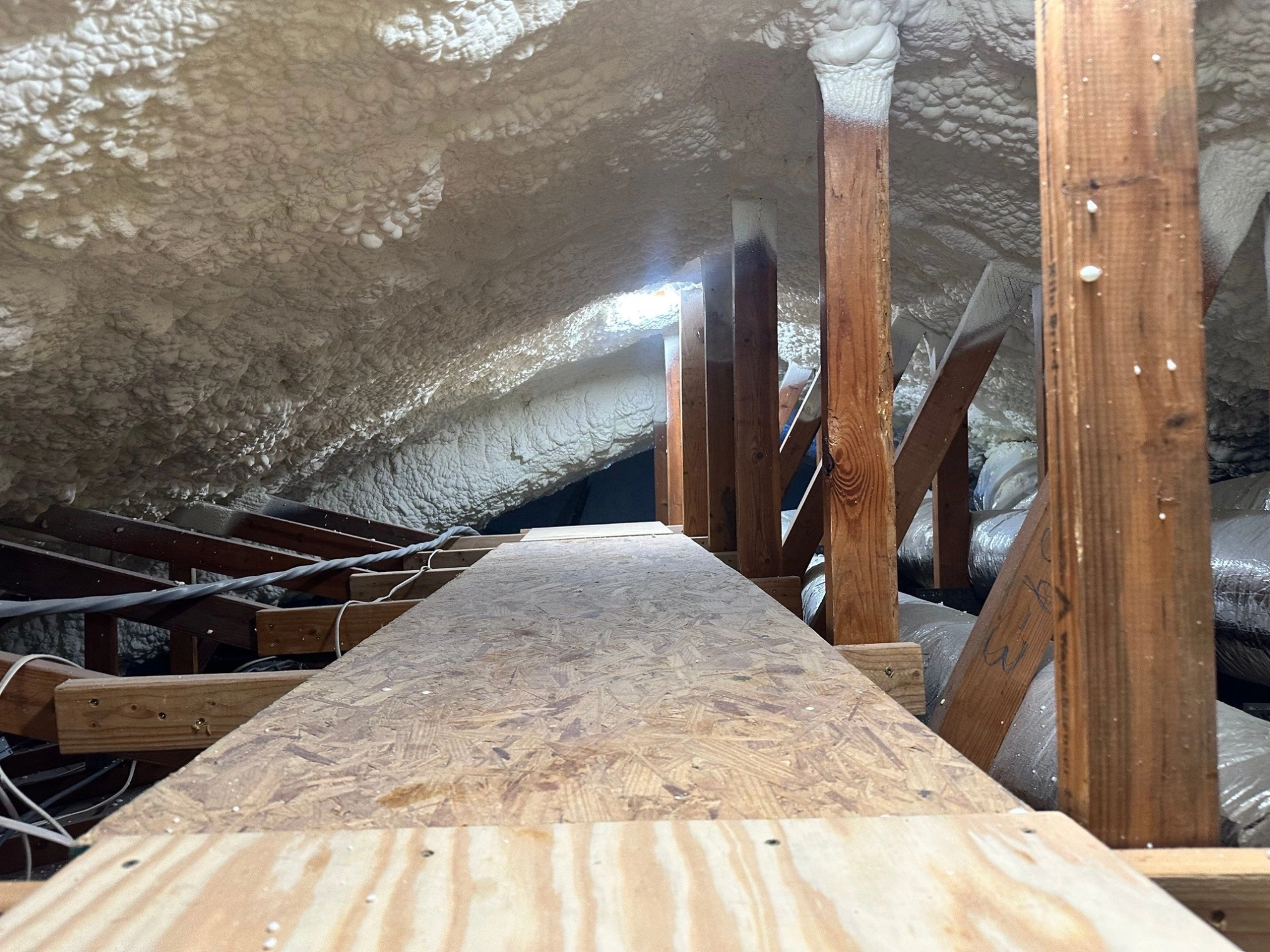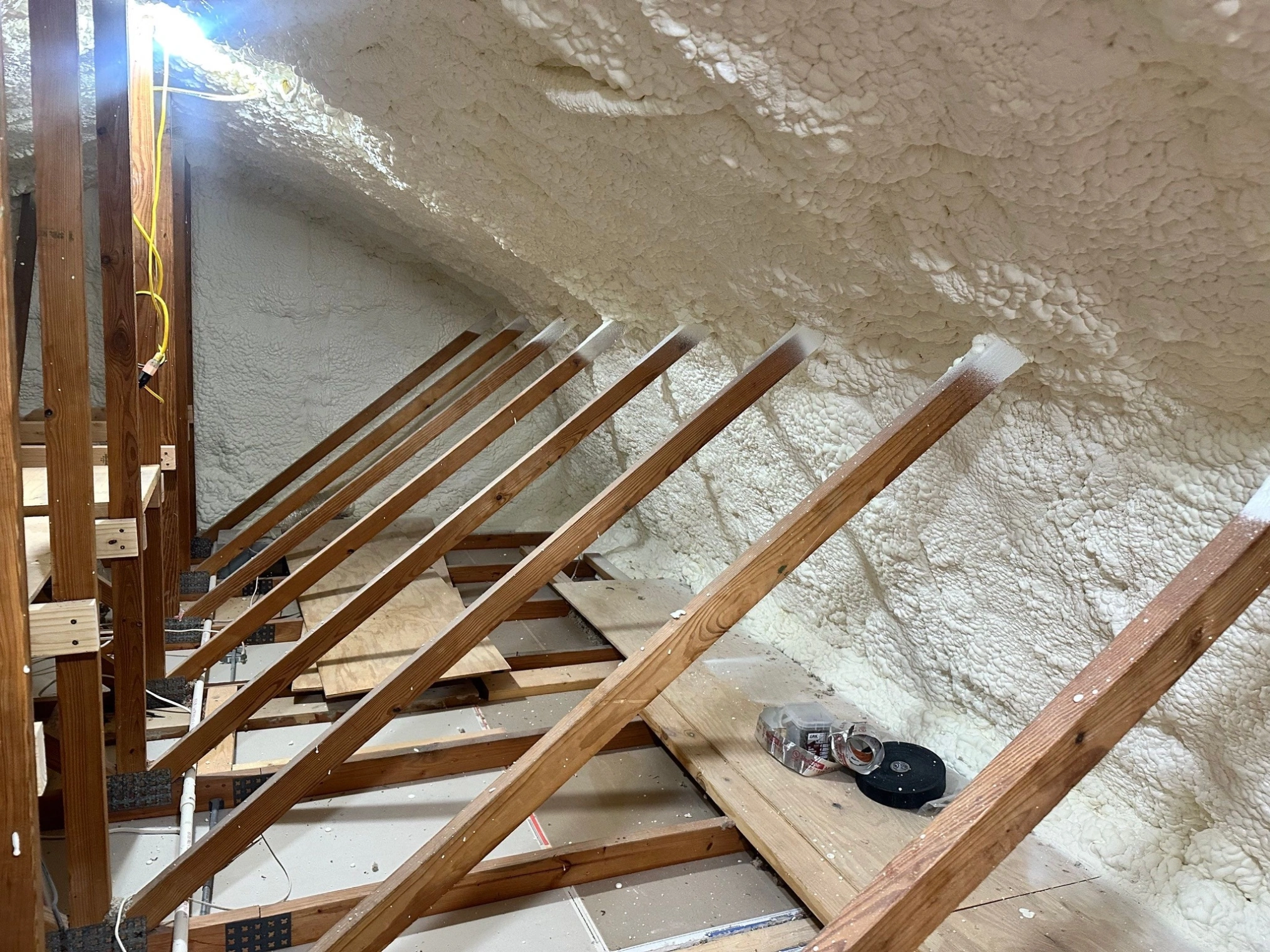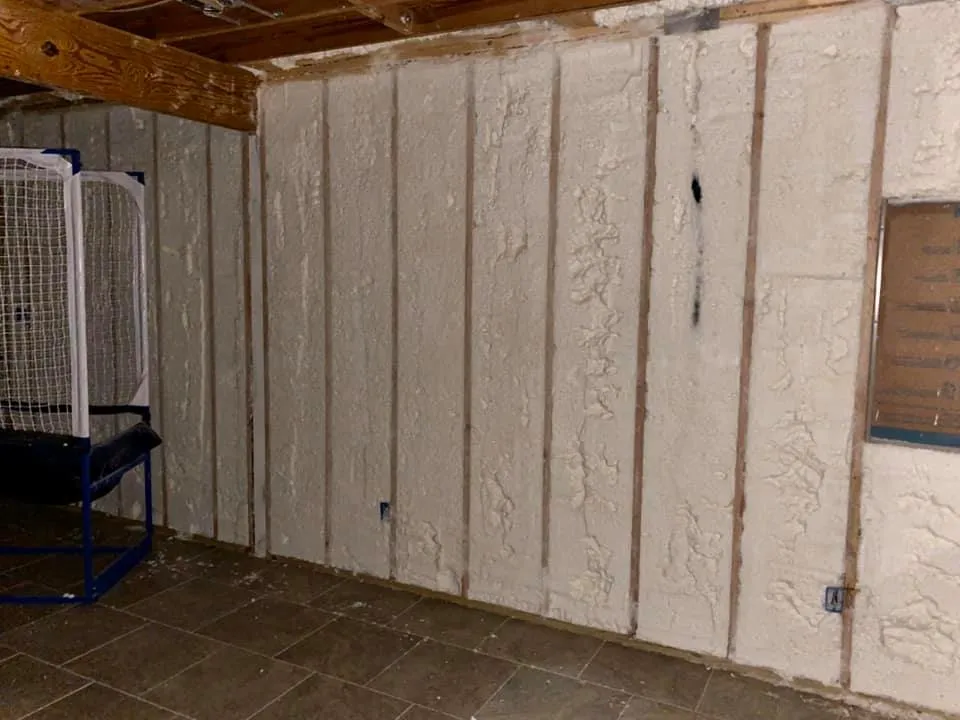Proper attic insulation directly reduces HVAC system workload by creating a thermal barrier that maintains consistent indoor temperatures, resulting in 15-30% energy savings and extending equipment lifespan by 3-5 years. Inadequate insulation forces heating and cooling systems to cycle more frequently, increasing wear on components and driving up operational costs significantly.
The relationship between attic insulation and HVAC efficiency operates through heat transfer prevention. Quality insulation minimizes thermal bridging, reduces ductwork strain, and maintains stable indoor environments that allow systems to operate within optimal parameters. Based on decades of insulation installation experience across various climate zones, homes with properly insulated attics demonstrate measurably lower HVAC maintenance requirements and superior energy performance.
Understanding the Thermal Performance Connection
Attic spaces without adequate insulation create significant thermal stress on HVAC systems. During summer months, uninsulated attics can reach temperatures exceeding 150°F, while winter conditions may drop to outdoor ambient levels. This temperature differential forces heating and cooling equipment to work harder to maintain comfortable indoor conditions.
Heat transfer occurs through three primary mechanisms in attic spaces: conduction through building materials, convection through air movement, and radiation from hot surfaces. Effective insulation addresses each pathway by creating resistance to heat flow and establishing a consistent thermal boundary between conditioned and unconditioned spaces.
Impact on System Cycling
HVAC systems experience reduced cycling frequency when attic insulation performs optimally. Frequent system starts and stops create mechanical stress on compressors, fan motors, and control systems. Research from the Department of Energy indicates that proper insulation can reduce system runtime by 20-25% while maintaining identical comfort levels.
Temperature fluctuations in poorly insulated homes trigger more frequent thermostat calls for heating or cooling. Each system startup consumes additional energy and creates component wear. Insulation stabilizes indoor temperatures, allowing longer, more efficient operating cycles that reduce mechanical stress.
Technical Specifications and Performance Data
| Insulation Type | R-Value per Inch | HVAC Load Reduction | Equipment Lifespan Extension |
|---|---|---|---|
| Open Cell Spray Foam | R-3.5 | 20-25% | 3-4 years |
| Closed Cell Spray Foam | R-6.0 | 25-30% | 4-5 years |
| Cellulose Blown-In | R-3.8 | 15-20% | 2-3 years |
| Fiberglass Batts | R-3.2 | 10-15% | 1-2 years |
Climate Zone Considerations
Different geographic regions require specific approaches to attic insulation for optimal HVAC performance. Hot, humid climates like central Texas benefit from vapor barriers and high R-values to combat cooling loads, while moderate climates focus on balanced thermal resistance for both heating and cooling seasons.
Moisture management becomes critical in humid regions where improper insulation installation can create condensation problems that damage HVAC ductwork and reduce system efficiency. Air sealing combined with appropriate insulation materials prevents moisture intrusion and maintains system performance.
Bonus Tip: Install insulation around HVAC ducts in unconditioned attic spaces to prevent temperature loss during air distribution. Properly insulated ducts can improve system efficiency by an additional 10-15%.
Ductwork Protection and Efficiency
HVAC ductwork located in unconditioned attic spaces loses significant energy when insulation levels are inadequate. Temperature differences between conditioned air inside ducts and extreme attic temperatures create substantial thermal transfer that reduces system efficiency and increases operational costs.
Insulation creates a buffer zone around ductwork, moderating temperature extremes and reducing thermal stress on distribution systems. This protection extends beyond energy savings to include condensation prevention, which protects metal ducts from corrosion and maintains indoor air quality.
Air Sealing Benefits
Comprehensive air sealing combined with insulation installation prevents conditioned air leakage that forces HVAC systems to compensate for lost heating and cooling capacity. Common leakage points include recessed lighting fixtures, electrical penetrations, and attic access points.
Professional air sealing can reduce HVAC workload by addressing infiltration and exfiltration that bypasses the building’s thermal envelope. According to Energy Star data, air sealing combined with insulation upgrades can improve HVAC efficiency by up to 40% in older homes.
Long-Term Equipment Benefits
HVAC systems operating in thermally stable environments experience reduced component wear and longer service intervals. Compressors, which represent the most expensive HVAC component, benefit significantly from consistent operating conditions that prevent excessive cycling and thermal stress.
Fan motors, control boards, and refrigeration components all demonstrate extended lifespans when insulation reduces system workload. Maintenance records from homes with upgraded attic insulation show 30-40% fewer service calls during the first five years following installation.
Warranty and Performance Considerations
Many HVAC manufacturers specify installation conditions that include proper insulation for warranty coverage. Inadequate insulation can void equipment warranties by creating operating conditions outside design parameters. Proper insulation ensures systems operate within manufacturer specifications and maintain warranty protection.
Bonus Tip: Document insulation R-values and installation dates for HVAC warranty purposes. Many manufacturers require proof of adequate building envelope performance for extended warranty coverage.
Energy Cost Analysis
| Annual Energy Savings | Insulation Investment | Payback Period | 10-Year ROI |
|---|---|---|---|
| $300-500 | $2,500 | 5-8 years | 120-200% |
| $500-800 | $4,000 | 5-7 years | 150-250% |
| $800-1200 | $6,000 | 5-6 years | 180-300% |
Energy cost reductions from proper attic insulation compound annually as utility rates increase. Homes in extreme climate zones demonstrate higher savings potential due to greater HVAC system usage throughout the year.
Things to Consider Before Making a Decision
Evaluate existing insulation levels before determining upgrade requirements. Many homes built before 1980 contain insufficient insulation by current standards, while newer construction may only need supplemental coverage in specific areas.
Consider HVAC system age when planning insulation upgrades. Older systems nearing replacement may benefit more from insulation improvements that extend equipment lifespan, while newer systems gain primarily from improved efficiency and reduced operating costs.
Assess moisture conditions in attic spaces before insulation installation. Existing leaks or ventilation problems must be addressed to prevent moisture damage that can compromise both insulation performance and HVAC system operation.
Determine local utility rebate programs and tax incentives available for insulation upgrades. Many regions offer substantial rebates that improve project economics and reduce payback periods significantly.
Bonus Tip: Schedule insulation installation during moderate weather periods when HVAC systems operate less frequently. This timing allows proper curing for spray foam applications and reduces disruption to home comfort.

Professional Insulation Solutions Stellrr Insulation & Spray Foam Provides
Stellrr Insulation & Spray Foam delivers comprehensive attic insulation solutions designed to optimize HVAC performance and extend equipment lifespan:
- Residential Spray Foam Insulation: Complete air sealing and thermal barrier installation using open cell or closed cell spray foam technology for maximum HVAC efficiency gains
- Attic Insulation: Strategic blown-in cellulose or fiberglass installation tailored to specific climate requirements and existing HVAC configurations
- Insulation Removal: Professional removal of damaged or inadequate existing insulation before installing high-performance replacement materials
- Wall Insulation: Comprehensive building envelope improvement that complements attic insulation for total HVAC system optimization
Key Performance Indicators
Monitor specific metrics to evaluate insulation impact on HVAC performance. Energy bill comparisons provide the most direct measurement of efficiency improvements, while system runtime data from smart thermostats reveals cycling frequency changes.
Indoor temperature stability improves noticeably with proper insulation, reducing temperature swings that trigger frequent HVAC operation. Humidity control also becomes more consistent as systems operate more efficiently within design parameters.
Track maintenance costs and service frequency to measure long-term equipment benefits. Document any warranty claims or component failures to establish baseline performance metrics for future comparison.
Common Questions About Attic Insulation and HVAC Systems
How quickly will I notice HVAC improvements after attic insulation installation?
Most homeowners observe reduced system runtime and more consistent temperatures within the first billing cycle. Complete efficiency benefits become apparent over 2-3 months as seasonal conditions vary.
Can insulation installation damage existing HVAC ductwork?
Professional installation protects existing ductwork through careful material placement and proper access planning. Quality contractor inspects and work around HVAC components without causing damage.
What insulation type provides the best HVAC performance benefits?
Closed cell spray foam delivers superior air sealing and thermal performance, resulting in maximum HVAC efficiency gains. However, proper installation technique matters more than material type for achieving optimal results.
Will insulation reduce my need for HVAC maintenance?
Proper insulation reduces system cycling frequency and operating stress, which typically extends maintenance intervals. However, regular professional maintenance remains essential for optimal equipment performance and warranty compliance.
Making the Right Investment Decision
Attic insulation represents one of the most cost-effective home improvements for HVAC performance enhancement. The combination of immediate energy savings, extended equipment life, and improved comfort creates compelling return on investment that compounds over time.
Consider insulation upgrades as preventive maintenance for HVAC systems rather than optional improvements. The modest upfront investment prevents costly equipment replacement and reduces ongoing operational expenses significantly.
Evaluate your specific situation based on current energy costs, HVAC system age, and long-term homeownership plans. Most scenarios demonstrate positive returns within 5-7 years, with continued benefits throughout the insulation’s 20-30 year lifespan.
Get Expert Insulation Guidance
Transform your home’s energy efficiency and extend HVAC system life with professional attic insulation solutions. Stellrr Insulation & Spray Foam provides comprehensive assessment and installation services designed to optimize your heating and cooling performance.
Contact the insulation specialists who understand the critical connection between thermal barriers and HVAC efficiency. Schedule your consultation to discover how proper insulation can reduce energy costs while protecting your equipment investment.
Stellrr Insulation & Spray Foam
Phone: (512) 710-2839
Email: info@stellrr.com
Frequently Asked Questions
Does attic insulation help both heating and cooling systems equally?
Insulation provides benefits for both heating and cooling systems, though the magnitude varies by climate zone. Cooling systems in hot climates typically show greater efficiency gains, while heating systems benefit more in cold regions with significant winter loads.
How much insulation is needed to achieve optimal HVAC performance?
Current building codes recommend R-38 to R-60 for attic spaces depending on climate zone, but HVAC optimization may require higher levels. Professional assessment determines the ideal R-value for specific system configurations and local conditions.
Can DIY insulation installation provide the same HVAC benefits as professional work?
Professional installation ensures proper air sealing, vapor barrier placement, and material coverage that DIY approaches often miss. These details significantly impact HVAC performance benefits and long-term system protection.
What happens to HVAC efficiency if insulation gets damaged or settles?
Damaged or settled insulation reduces thermal resistance and can create air leakage paths that compromise HVAC efficiency. Regular inspection and maintenance preserve insulation performance and protect system benefits.
How do I know if my current insulation is affecting HVAC performance?
Signs include frequent system cycling, uneven temperatures between rooms, high energy bills relative to similar homes, and excessive runtime during moderate weather conditions. Professional energy audits provide definitive assessment of insulation adequacy.





